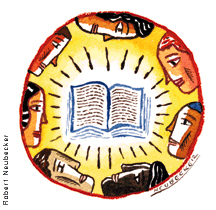
For the past three decades, Dr. Douglas S. Massey points out, colleges and universities have had mixed results in their efforts to recruit and retain minority candidates. There have been plenty of success stories, but the fact remains that—generally speaking—African Americans, Latinos and certain other minorities tend to drop out at higher rates than their white counterparts and generally “achieve at lower levels of distinction,” as measured by the usual academic yardsticks. Even when such factors as SAT scores and family income are controlled for, the racial and ethnic disparities persist. No one really knows why.
“There are a lot of speculations and ideas and theories, some better grounded in empirical work than others,” says Massey, the Dorothy S. Thomas Professor of Sociology in the Population Studies Center who serves as chairman of the sociology department, “but there really hasn’t been any effort to make a definitive assessment about what determines whether someone is relatively successful or unsuccessful in higher education—and how that might differ from group to group.”
Which is why Massey and Dr. Camille Z. Charles, assistant professor of sociology, are embarking on an exhaustive, five-year longitudinal study examining the academic performance of some 4,170 students—white, black, Latino and Asian—at 35 selective colleges and universities around the country. It is being funded by the Andrew W. Mellon Foundation, whose president, Dr. William G. Bowen, former president of Princeton University, also co-wrote a book on the subject titled The Shape of the River. (Bowen’s co-author was former Harvard University President Derek Bok.)
The study will combine detailed information about the students’ pasts as well as their evolving experiences in college. In the “baseline survey,” the incoming freshmen fill out a lengthy questionnaire focusing on three critical junctures in their lives: ages six, 13 and 18. “We ask detailed questions about what is going on in their families and their schools and in their neighborhoods at those ages,” says Massey, “and then in the spring, we reinterview the same students and ask them what has happened to them in their first academic year.” The spring interviews will include detailed estimates of the amount of time the students spend in different activities—”from sleeping to partying to studying to attending class,” says Massey—as well as information about their “experiences on campus and their attitudes towards different groups and situations.” The surveys will be conducted by the Institute for Survey Research at Temple University, which will conduct follow-up interviews each spring for the next four years.
Penn, which is contributing 50 entering freshmen from each of the four groups this year, also served as the source of a pilot study for the project in the fall of 1998. Among the pilot study’s findings were that immigrants and children of immigrants were “over-represented among minority groups, especially African Americans”; that African Americans were “far more likely” to have had their time taken up with household chores while they were growing up than other groups; that “romance on campus was more likely for whites than for other groups”; that “minorities generally spent more time studying than whites”; and that minorities, especially blacks and Latinos, were “more likely to work while attending college” than Asians or whites.
Although these and other differences are “interesting and intriguing,” notes Massey, “we still don’t know what they mean to students or how they affect various social and academic outcomes.”
Massey is hopeful that the results of the larger survey will show “a lot of subtle, sometimes psychological processes involved in success—or failure—as they unfold in the students’ lives.” And when students drop out of a particular school, he notes, “we’re going to follow them—because we don’t want to build a bias into the study. Simply because you drop out of Penn doesn’t mean you’re washed up.” By the final, fifth year of the study, most students will have graduated.
Massey, author of the highly acclaimed American Apartheid, notes that much of his own work has focused on examining “neighborhood conditions that rise out of the fact that we’re a segregated society.” He expects that the national study will suggest a “complex interplay of factors—socioeconomic issues; neighborhood issues; issues of resources that one grew up with, both in the family and in neighborhoods and schools—that may be variable even when you hold income constant.” And he hopes that by teasing out those different factors—as well as certain psychological processes unique to the minority experience—he and Charles will be able to come up with a “fairly accurate picture to explain relative success in higher education for different groups.”
But when it comes to directing the project, he doesn’t want to “lean one way or the other” when it comes to possible explanations, he adds. “I want to test them all out on an equal playing field.”
Asked about the political landmines involved in such a study, he responds: “When you work in the area of race, you can’t do anything important without making somebody mad. So my job as a social scientist is to come to the best possible understanding of the processes responsible for success in higher education, and to build good theoretical models that are empirically grounded to describe them. And then make that knowledge available to policy-makers.”

